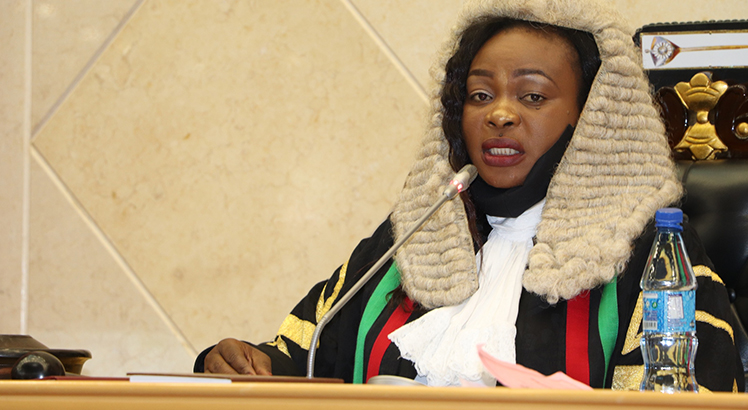Humanitarian tragedy at Kapise Refugee Camp
When some asylum seekers begun settling at Kasipe Refugee Camp in Mwanza last year, they thought they would be there temporarily.
But time has stretched.
Shared among group village heads (GVHs) Kapise, Kasudza and Ntasa under Senior Chief Nthache, the camp currently accommodates some 11 300 Mozambican asylum seekers who have fled, and continue escaping from their country due to conflicts between government and opposition soldiers.
However, life at this top-of-hill settlement camp, situated just about 500 metres away from the Malawi-Mozambique border and about 20 km North West of Mwanza Boma, leaves a lot to be desired. It is a nightmare.
Crammed on two pieces of land under Kapise I and Kapise II Refugee Camp, the asylum seekers are living in desperate conditions.

bag of relief maize at the camp
Several asylum seekers are yet to be provided with tarpaulin tents by the United Nations High Commissioner for Refugees (UNHCR) and have erected makeshift shelters from wood and grass.
And every moment, as hundreds others join the camp; they scramble for space and other necessities for their day-to-day life.
The people had walked for days, many of them with just clothes on them, to reach the camp with the hope of finding some rest.
But the continued dilly-dallying by the governments of Mozambique and Malawi in finding a lasting solution to the problem is creating untold misery for them despite the presence of several charities.
Scores others have been separated from their relations whom they do not know whether they are alive or not. Their vulnerabilities are immense, but they have vowed not to return home.
Some do not even remember when they last had their food ration. They have largely been left to fend for themselves; hence, creating fears that once their food is finished they may start raiding nearby communities to steal.
Others are surviving and living at the mercy of the surrounding communities who give them piece works in their gardens.
The situation is largely frightful for girls, some of whom are already teen mothers, but also pregnant.
Mwanza District Hospital has reportedly recorded about 30 new births at the camp so far.
The camp also has no adequate water supply let alone sanitation facilities. Coupled with the food shortage, the refugees are at risk of contracting diverse illnesses.
Already several children are showing signs of severe malnutrition due to inadequate food.
But scores of other locals still quietly volunteer their resources and donate their little possessions and resources.
Most family members are overcrowded in one bedroomed and poorly regard for their ages and sexes. ventilated shelters without
Every day, UNHCR said yesterday, about 250 asylum seekers are trickling in, thereby overstretching the relief resources.
So far, three children, aid workers confided in The Nation, have died due to waterborne related illnesses while in camp with the recent death being of a four-month old baby last Friday.
There are only two water points at the camp which cater for the entire refugee population, including the estimated 150 families of the host community.
The humanitarian minimum standards demand that each person have at least 15 litres of water daily for drinking and cooking, but at Kasipe camp, on average, each person gets below 10 litres.
Still, whereas the respect of minimum humanitarian conditions requires at least one latrine for 25 people, the camp has less than 30 functioning latrines translating into one latrine for more than 330 people.
Further, the organisations helping the refugees are also breaching the international humanitarian standards located at least 40 kms away from the border.that a refugee camp must be
The presence and influx of the refuges is also worrying some locals surrounding the camp who say they are living in fear.
“Once they run out of food, they may start stealing from our homes. Similarly, we never know some of them may have fled with weapons which they could use against us,” said Andrew Sodzapanja from Kasudza Village.
Today, many of the refugees fear they will no longer ever say “my home” because what they left has now been or will be destroyed forever.
But despite the challenges they are facing, most of them are happy living at the camp than in their home country, according to 30-year-old Agness Alfredo of Nagalu in Nkondezi district:
“I first came here last year when hostilities were not bad. But I returned home because of the unbearable living conditions at the camp. However, I am now back and I would rather stay here for life than get killed or witness my relatives being massacred. I do not want to go back to Mozambique,” she vowed.
Elsie Bertha Mills-Tetty, UNHCR field officer for Mwanza, told The Nation many families are female-headed and either have children or are pregnant.
“Women come with their children; some do not know their husband’s whereabouts. There are also many teen marriages, with girls as young as 12 or 13 years already in marriage,” explained Mills-Tetty in an interview
However, the solace is that UN agencies have now stepped up efforts in providing non-food items such as medical treatment supplies, tents and school supplies for temporary classrooms to the displaced people.
So far, WFP has provided about 240 metric tons of diverse food commodities, including fortified blended foods to prevent malnutrition and micronutrient deficiencies among the population, and children under age two in particular.
For children who may have slipped into severe acute malnutrition, Unicef has set up treatment services, alongside its efforts to improve water, hygiene and sanitation in the settlement.





